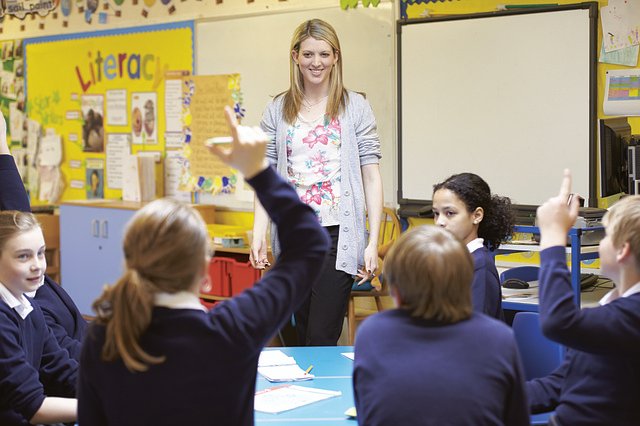SARS-CoV-2 transmission model suggests primary school infection could be greater this autumn than in 2020

The study, published on the preprint server medRxiv, is led by Dr Mark Woodhouse from Bristol’s Schools of Earth Sciences and Mathematics, working with colleagues in Earth Sciences, Bristol Veterinary School and with specialists in public health and infectious diseases on the CoMMinS (COVID-19 Mapping and Mitigation in Schools) project.
The new agent-based model characterises the numbers of daily close contacts that can occur in primary school classrooms, involving pupils and teachers and provides a basis for assessing likely rates of Covid-19 infection transmission and infections within classrooms in the new term. The model takes into account the infection dynamics of the new Delta variant of SARS-CoV-2 and changing guidance for mitigation measures in schools.
The pre-print reports advances in computational probabilistic modelling for estimating in-school infection risks, building on earlier studies by Bristol colleagues (Sparks et al; Aspinall et al). The new analytical framework is based on developments in characterising, statistically, the complexities of child-with-child and child-with-teacher interactions within the classroom, and how these are modulated by classroom management controls for reducing infection spread.
A previous study (Sparks et al) demonstrated that pupils’ interactions with one another have a distinctive statistical profile: some children are not extensive mixers, whilst others are very sociable and have many, many contacts in the school day. The latter children may act as “super-spreaders” in a class or school if they pick up a Covid-19 infection in the community or from another child.
Mitigation strategies to control infection are modelled to allow analysis of their effectiveness in supressing infection outbreaks in classrooms and in limiting pupil absence. The model was applied to re-examine Covid-19 in schools in the UK in autumn 2020 and, with some fine-tuning, is now run to forecast infection levels in autumn 2021 when the more infectious Delta variant is anticipated to be dominant and school transmission could be a major concern in any new wave of the epidemic.
Using forecasts that are tracking current upward trends in incidence rates in the UK, key findings and implications from the model include:
- Substantial Covid-19 outbreaks could occur in primary schools during the Autumn term.
- A small proportion of primary schools (less than one per cent) might experience outbreaks, as defined by the DfE1 and that there will be more such outbreaks than in 2020.
- Most primary schools are expected to experience at least one classroom infection case.
- A comparison of alternative mitigation measures indicates that bubble quarantining is less effective in reducing infection in primary schools when compared to testing-based surveillance and removing children when they become symptomatic.
- Bubble quarantining is highly disruptive to education but offers little public health benefit. However, bubble quarantining may be considered necessary to manage large outbreaks in primary schools1.
- Lateral flow testing-based surveillance achieves a greater reduction in numbers of infected pupils compared to bubble quarantining. Confirmatory PCR testing has very little benefit in reducing infection levels in the classroom but can reduce quarantine time for false-positive rapid tests.
- The study confirms that individual school’s policies that encourage social distancing together with other measures like ventilation and hygiene and routine lateral flow testing can reduce infection transmission, but the researchers recognise there are practical limits to such policies, especially with primary school age children.
The study’s findings indicate that testing-based surveillance of infections in the classroom population with isolation of positive cases is a more effective mitigation measure than bubble quarantining both for reducing transmission in schools and for avoiding pupil absence, even accounting for insensitivity of self-administered tests. Bubble quarantining results in large numbers of pupils absent from school, with only modest impact of classroom infection. However, maintaining a reduced contact rate within the classroom has a major beneficial impact for managing Covid-19 in school settings.
Dr Mark Woodhouse, Knowledge Exchange Fellow in the Schools of Earth Sciences and Mathematics, said:
“Schools re-opening for the new school year face the prospect of managing and mitigating risks associated with the evolving Covid-19 pandemic outbreak in England and, in particular, the aggressive dynamics of the Delta variant of the coronavirus, which is growing in prevalence.
“Mathematical models are being used extensively to help understand the probability of the virus being transmitted between persons, to inform prevention and control strategies. For schools, our findings suggest there are substantive implications for the relative efficacies of different mitigation measures that may be followed. For instance, our modelling presents evidence that, with the emergence of the Delta variant and other changing factors, there is likely to be a distinct contrast between the efficacies of bubbles and of regular testing when it to comes to projected numbers of infections in schools and pupil absences in the first few weeks of the new academic year. In addition, our results indicate potential benefits from refocusing on social distancing in schools, as well as enhanced ventilation and good hygiene.”
Professor Sir Stephen Sparks FRS, Emeritus Professor in the School of Earth Sciences at the University of Bristol, added:
“We believe our study projections provide important information for policy considerations, especially in relation to absences from school that will be consequent on choices of different mitigation measures. There is the prospect that schools could become driver reservoirs of community infection, rather than the other way around, as was the case with the Alpha variant.
“These, and related arguments from our modelling, suggest that – in forecast mode – our stochastic contact network framework should be of value to Directors of Public Health and Education Authorities charged with responsibility for prompt assessment and managing of infection transmission dynamics in classes, schools and in multiple schools in a given education authority area or wider region. In terms of current or future DfE criteria for school actions, our model can be tailored straightforwardly to different schools’ demographics and to the relevant local community incidence level.”
The study was funded in part by the Medical Research Council, via CoMMinS hosted within the MRC Integrative Epidemiology Unit at the University of Bristol and by NERC and the University of Bristol; while there was no direct funding, the support of the Royal Society RAMP initiative for COVID-19 is acknowledged.
Paper
‘Analysis of alternative Covid-19 mitigation measures in school classrooms: an agent-based model of SARS-CoV-2 transmission‘ by Mark Woodhouse, Willy Aspinall and Stephen Sparks with the Bristol University CoMMinS Project in medRxiv
Please note this is a preprint, it is a preliminary piece of research that has not yet been through peer review and has not been published in a scientific journal – so these are provisional findings










Responses